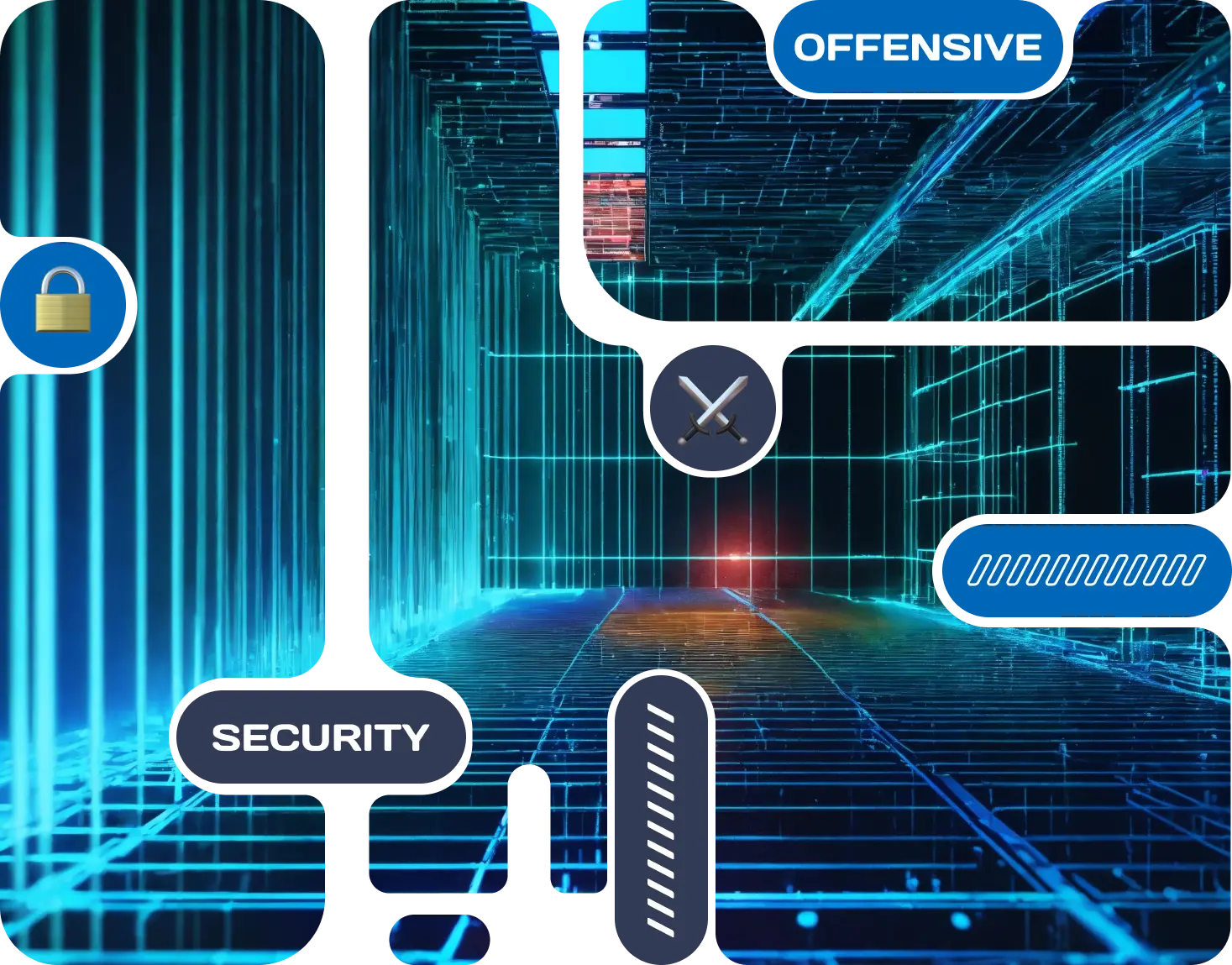Services / Offensive Services
Offensive Services
Our company offers a wide range of cybersecurity services, ensuring robust protection for your organization against various threats.

What is Offensive services?
//////////////
Our company offers a wide range of cybersecurity services, ensuring robust protection for your organization against various threats. Our experts specialize in penetration testing, Google Cloud (GCP) and Azure security audits, OSINT RECON analysis, smart contract audits, IoT security audits, and social engineering.
We employ cutting-edge methods and tools to identify vulnerabilities and secure your infrastructure and data. Our goal is to provide your business with high-level security and shield it from modern cyber threats. Our comprehensive cybersecurity services encompass thorough assessments, proactive testing, and strategic solutions tailored to your organization’s unique needs.
By partnering with us, you gain access to a team of dedicated professionals committed to safeguarding your digital assets and maintaining the integrity of your operations.
Our Offensive services

Penetration
Testing
Penetration testing as a service is a simulation of a hacker’s actions in order to identify vulnerabilities and assess the security of both external and internal information systems.

Google Cloud (GCP) Service
Empower your company’s cybersecurity with industry-leading practices. Our Company leverages advanced automation techniques and certified professionals to deliver actionable reports.

Azure Security
Audit
An Azure security audit involves assessing the security measures and controls implemented to safeguard an organization’s Azure environment. Its purpose is to detect vulnerabilities or risks within the environment.

OSINT / RECON
Service
OSINT/RECON is a defensive practice for safeguarding information assets. Intelligence gathering and analysis adhere to specific requirements and cybersecurity regulations.

Smart Contract
Audit
A smart contract, akin to traditional agreements, houses business logic, integrates with the blockchain, and executes specific actions upon meeting predefined conditions.

IOT Security
Audit
IOT Security Audit Service is a service aimed at auditing the security of Internet of Things (IoT) systems, including vulnerability assessment, risk evaluation, and recommendations for mitigation.

Social
Engineering
Social engineering manipulates people to access sensitive information or resources by exploiting human psychology, not technical means. It aims to trick individuals into revealing confidential data.

API Penetration
Testing
API penetration testing services safeguard your company’s digital assets through comprehensive security testing. With the rise in cyberattacks, ensuring protection against vulnerabilities is crucial.

Perfomance
Testing
Performance Testing evaluates system stability and performance metrics under heavy external loads. Our experts vary the load intensity to provide a comprehensive assessment.
Cybersecurity Services: Overview, Benefits, and Recommendations
Penetration Testing, often referred to as pen testing, is a cybersecurity service that involves simulating real-world cyberattacks on an organization's systems, networks, or applications to identify vulnerabilities and weaknesses that could be exploited by malicious actors. During a penetration test, ethical hackers, known as penetration testers or "white-hat" hackers, attempt to exploit security flaws using techniques similar to those employed by attackers. The goal is to uncover potential security gaps before they are exploited by malicious actors, allowing organizations to proactively address and mitigate risks. Penetration testing helps organizations assess the effectiveness of their security controls, identify areas for improvement, and enhance overall cybersecurity posture.
Google Cloud (GCP) Service refers to a suite of cloud computing services offered by Google to help businesses build, deploy, and manage applications and infrastructure in the cloud. Google Cloud provides a wide range of services, including compute, storage, networking, databases, machine learning, artificial intelligence, big data analytics, security, and developer tools. These services are delivered through Google's global network of data centers, offering scalability, reliability, and performance to meet the needs of businesses of all sizes. Google Cloud enables organizations to innovate faster, reduce IT costs, improve agility, and scale their operations seamlessly, leveraging the power of cloud computing technologies.
An Azure Security Audit is a comprehensive assessment of the security controls, configurations, and practices within an organization's Microsoft Azure environment. The audit aims to identify vulnerabilities, misconfigurations, and compliance gaps that could pose security risks to Azure resources and data. During the audit, security professionals review various aspects of Azure services, including identity and access management, network security, data encryption, logging and monitoring, and compliance with industry standards and regulatory requirements. The findings from the audit help organizations enhance their security posture, mitigate risks, and ensure the protection of sensitive information and assets hosted on the Azure platform.
OSINT Recon, short for Open Source Intelligence Reconnaissance, is a process of gathering publicly available information from various online sources to gain insights and intelligence about individuals, organizations, or entities. It involves using tools, techniques, and methodologies to collect data from sources such as social media platforms, public databases, websites, forums, and other online sources. OSINT Recon is commonly used for threat intelligence, security assessments, competitive analysis, due diligence, and investigative purposes. By analyzing the gathered information, analysts can identify potential risks, vulnerabilities, and threats, as well as gain a better understanding of their targets and their activities. OSINT Recon plays a crucial role in cybersecurity, intelligence gathering, and decision-making processes across various domains.
A Smart Contract Audit is a thorough review and assessment of the code and functionality of a smart contract deployed on a blockchain platform, such as Ethereum. Smart contracts are self-executing contracts with the terms of the agreement directly written into code. The audit aims to identify potential vulnerabilities, bugs, and security risks within the smart contract code that could lead to financial loss, manipulation, or exploitation by malicious actors. During the audit, security experts analyze the codebase, conduct static and dynamic analysis, review the logic and business rules, and assess compliance with best practices, standards, and security guidelines. The findings from the audit help ensure the integrity, reliability, and security of the smart contract, as well as mitigate potential risks for all parties involved in its execution. Smart contract audits are essential for projects seeking to deploy decentralized applications (DApps), token sales, decentralized finance (DeFi) protocols, and other blockchain-based solutions.
An IoT (Internet of Things) Security Audit is a comprehensive assessment of the security measures, configurations, and practices associated with IoT devices, networks, and ecosystems. The audit aims to identify vulnerabilities, weaknesses, and potential risks that could compromise the security, privacy, and functionality of IoT systems. During the audit, security professionals evaluate various aspects of IoT deployments, including device authentication and authorization mechanisms, data encryption, network segmentation, firmware integrity, access controls, and compliance with industry standards and regulations.
Key components of an IoT Security Audit may include:
Device Assessment: Evaluating the security features and configurations of individual IoT devices, including authentication mechanisms, encryption protocols, and firmware update capabilities.
Network Security: Assessing the security posture of IoT networks, including wireless protocols, communication channels, access points, and traffic encryption methods.
Data Protection: Reviewing data handling practices, storage mechanisms, and encryption techniques to ensure the confidentiality, integrity, and availability of IoT data.
Access Control: Examining access controls and permissions management mechanisms to prevent unauthorized access to IoT devices and sensitive data.
Vulnerability Scanning: Conducting vulnerability scans and penetration tests to identify security weaknesses, misconfigurations, and potential entry points for attackers.
Compliance and Governance: Verifying compliance with relevant regulations, standards, and industry best practices governing IoT security, privacy, and data protection.
Incident Response: Assessing the readiness and effectiveness of incident response plans and procedures to detect, respond to, and mitigate IoT security incidents and breaches.
By performing an IoT Security Audit, organizations can proactively identify and address security gaps, mitigate risks, and enhance the overall security posture of their IoT deployments, thereby safeguarding against potential cyber threats and protecting critical assets and data.
Social Engineering is a tactic used by malicious actors to manipulate individuals into divulging confidential information, performing actions, or providing access to sensitive systems or data. Unlike traditional hacking methods that exploit technical vulnerabilities, social engineering exploits human psychology and interactions to deceive or trick victims into unwittingly revealing information or taking actions that benefit the attacker.
Examples of social engineering techniques include:
Phishing: Sending deceptive emails, text messages, or instant messages that appear to be from legitimate sources, such as banks or trusted organizations, to trick recipients into revealing personal information, passwords, or financial details.
Pretexting: Creating a fabricated scenario or pretext to gain the trust of a target, such as posing as a customer service representative or IT support technician to solicit sensitive information or access.
Baiting: Leaving infected USB drives, CDs, or other physical media in public places or mailing them to targets, enticing individuals to insert them into their computers and unwittingly install malware or reveal sensitive information.
Tailgating: Physically following or accompanying authorized individuals into restricted areas or secure facilities by exploiting their trust or courtesy, bypassing security controls.
Impersonation: Pretending to be someone else, such as a coworker, executive, or trusted authority figure, to manipulate individuals into divulging information, providing access, or performing actions.
Social engineering attacks can be highly effective because they exploit human nature, trust, and vulnerabilities, making individuals the weakest link in an organization's security defenses. Effective defenses against social engineering include employee training and awareness programs, implementing strong authentication and access controls, and maintaining a culture of skepticism and caution when interacting with unfamiliar or unexpected requests.
API Penetration Testing is a specialized security assessment conducted on the Application Programming Interfaces (APIs) of an application or service to identify and address potential vulnerabilities and security risks. APIs allow different software components to communicate and interact with each other, making them a common target for attackers seeking to exploit weaknesses in authentication, authorization, input validation, data integrity, and other security controls.
During API Penetration Testing, security professionals use various techniques to simulate real-world attacks and assess the security posture of APIs, including:
Authentication Testing: Evaluating the effectiveness of authentication mechanisms used by the API, such as API keys, OAuth tokens, or session cookies, to ensure that only authorized users can access the API.
Authorization Testing: Assessing the access controls and permissions management implemented by the API to prevent unauthorized users from accessing sensitive data or performing privileged actions.
Input Validation Testing: Checking for vulnerabilities such as injection attacks (e.g., SQL injection, XML injection) by sending malformed or malicious input data to the API and observing how it handles and processes the input.
Data Validation and Output Encoding: Verifying that the API properly validates and sanitizes input data to prevent common security vulnerabilities such as Cross-Site Scripting (XSS) and Cross-Site Request Forgery (CSRF).
Session Management Testing: Evaluating how the API manages user sessions and handles session tokens to prevent session fixation, session hijacking, and other session-related attacks.
Error Handling and Logging Analysis: Assessing how the API handles error conditions and logs sensitive information, ensuring that error messages do not leak sensitive data or provide attackers with insights into system internals.
Rate Limiting and Throttling Testing: Checking for rate limiting and throttling mechanisms to prevent brute force attacks, denial-of-service (DoS) attacks, and other abuse of API resources.
Security Headers and Transport Security: Verifying that the API implements proper security headers (e.g., Content Security Policy, Strict Transport Security) and encryption protocols (e.g., HTTPS) to protect data in transit and prevent common security risks.
By conducting API Penetration Testing, organizations can identify and remediate security vulnerabilities in their APIs, thereby reducing the risk of data breaches, unauthorized access, and other security incidents. Additionally, API Penetration Testing helps organizations demonstrate compliance with regulatory requirements and industry standards for data protection and security.
Performance Testing is a type of software testing that evaluates the speed, responsiveness, scalability, and stability of an application or system under various load conditions. The goal of performance testing is to ensure that the application meets specified performance criteria and can handle the expected workload without degradation in performance or disruptions.
Key aspects of Performance Testing include:
Load Testing: Assessing the application's performance under anticipated user loads by simulating concurrent user activity. Load testing helps identify performance bottlenecks, such as slow response times or resource exhaustion, and ensures that the application can handle peak loads without performance degradation.
Stress Testing: Evaluating the application's ability to handle extreme or beyond-normal conditions, such as heavy traffic, spikes in user activity, or resource constraints. Stress testing helps uncover system weaknesses and assesses how the application behaves under adverse conditions.
Scalability Testing: Testing the application's ability to scale resources, such as CPU, memory, or storage, to accommodate increasing user loads or data volumes. Scalability testing helps ensure that the application can efficiently scale up or scale out to meet growing demands without performance degradation.
Volume Testing: Assessing the application's performance with large volumes of data, such as database records, files, or transactions. Volume testing helps identify performance issues related to data storage, retrieval, and processing, and ensures that the application can handle data growth without performance degradation.
Endurance Testing: Evaluating the application's performance over an extended period under sustained loads to identify memory leaks, resource leaks, or other issues that may cause performance degradation over time.
Concurrency Testing: Assessing the application's performance when multiple users or processes access and interact with the system concurrently. Concurrency testing helps identify synchronization issues, race conditions, and contention for shared resources that may impact performance.
Performance Testing is essential for ensuring that applications meet performance requirements, deliver a positive user experience, and can scale to meet growing demands. By identifying and addressing performance issues early in the development lifecycle, organizations can minimize the risk of performance-related outages, downtime, and user dissatisfaction.
get in touch!
Get a quote and we will contact you shortly
Our media
Our contacts